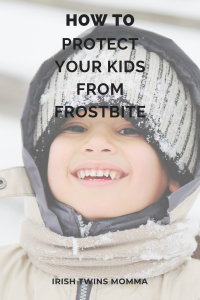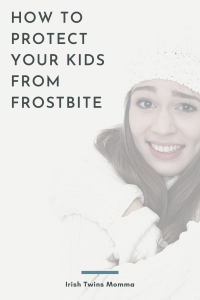This post contains affiliate links. If you click and buy, I may make a commission, at no cost to you. See my disclosure policy for more information.
Outdoor play is a great way to keep the kids entertained and active during the winter. However, it does not come without its risks. Without the proper precautions, your children run the risk of getting frostbite in the cold weather. This article will teach you how to protect your kids from frostbite, as well as how to identify and treat it.
What Is Frostbite?
Frostbite is a skin injury caused by the cold. The injury can affect the surface of the skin and in severe cases, sometimes even the muscles or bones. Because children lose heat faster than adults, they are particularly susceptible to frostbite on their fingers, toes, ears, noses, and other exposed skin. Frostnip is a mild form of frostbite in which skin will look red or feel slightly numb. Frostbitten skin will appear grey or white and will be hard to the touch. The area will usually also be numb.
Protecting Your Kids From Frostbite
Dress Them in Warm Clothes
The best way to protect your kids from frostbite is to keep them warm, and one way to do this is by dressing them properly for the winter weather. Dress your kids in layers that will keep them warm and dry. These should include a well-fitting base layer, an insulating mid-layer, and a warm, water-repellent outer layer. Be sure to choose quality thermals for your kids, as those will keep your kids warm and dry with the best results.
Cover Their Extremities
In addition to layers, be sure to dress your kids in winter accessories that will cover all their extremities. This includes scarves, hats, mittens, warm socks, and waterproof boots. These accessories are especially important since they protect the areas most often affected by frostbite.
Limit Outdoor Play in Cold Weather
Especially in extremely cold weather, monitor your children’s outdoor play and limit it if necessary. Even if it’s not extremely cold, prolonged time playing outside in the cold can bring on frostbite, and if not told to come inside, a child might just ignore these symptoms and keep playing in the snow.
How To Treat Frostbite
If (even after taking measures to protect against it) one of your children still gets frostbite, you’ll need to seek out appropriate treatment immediately. Mild frostnip is easy to treat at home. Bring your child in and warm the affected area with blankets or a hot bath. Do not rub the affected area. If your child has developed frostbite, this is a more serious issue. Take your child to the emergency room right away for medical treatment. In the meantime, warm the affected area as much as possible.
Now that you’ve learned how to protect your kids from frostbite, you understand it can have serious, long-lasting consequences. As such, be vigilant against it for your children’s sake and for your own as a parent.
Sincerely,





Leave a Reply